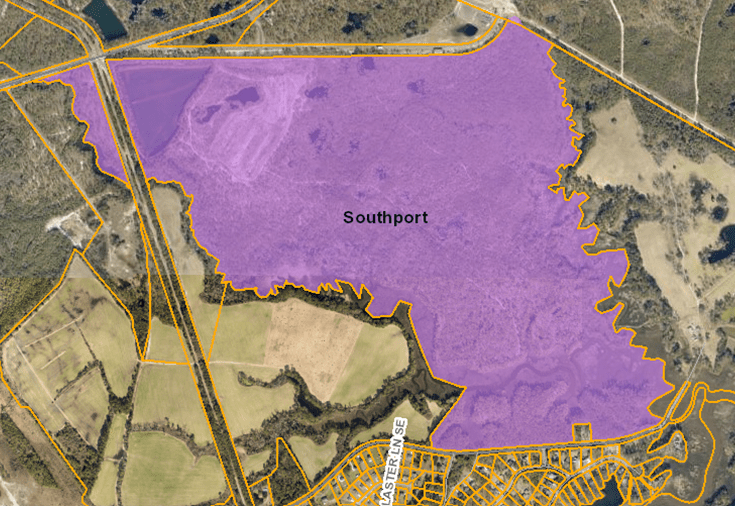Reprinted from the Tideland News
SWANSBORO — Though it is a relatively small project, the Parrish Green subdivision is significant. Proposed by Jordan Building Company, the five single-family building lots on Swansboro’s Phillips Drive will be the first low-impact development subdivision in Onslow County.
For Parrish Green Phase I to be developed LID, Swansboro had to relax a couple of code requirements. The board of commissioners’ recent action to approve the project was unanimous.
Supporter Spotlight
David Newsom of Crystal Coast Engineering, representing the developer, asked town commissioners for two variances at the Aug. 20 meeting. He offered details on the project that he and his partner, John Freshwater, put together. Specifically, the builder needed a variance from Article 20, Sections 20-18 and 20-21 of the Subdivision Ordinance related to the curb and gutter and sidewalk requirements.
 Lauren Kolodij |
“This will be John and mine’s first LID project,” Newsom told the commissioners during a public hearing on the request. “It will be the first in Onslow County. I think it will be a real boon to the town if we do this.”
Using LID as opposed to conventional development involves different methods of controlling stormwater that mimic natural hydrology. Channeling of runoff by curb and gutter must be limited, as must the amount of impervious surface within the development.
But first the developers needed variances to two town ordinances. Swansboro’s Subdivision Regulations state: “Curb and gutters shall be required in all subdivisions unless a variance from this requirement is specifically granted by the board of commissioners.” Also, the ordinance states: “Unless a variance for this requirement is granted by the board of commissioners, sidewalks are required along both sides of all streets constructed in an approved subdivision …”
What Newsom was asking for was the ability to develop a 10-inch concrete edging, rather than a curb and gutter, and to eliminate the sidewalk on one side of the street. The variances would allow the development to meet the standards of LID, which is aimed at providing on-site treatment of storm water.
Supporter Spotlight
By eliminating the curb and gutter, runoff would be unhindered in flowing to the onsite stormwater control measure. Eliminating sidewalks on the north side of the street reduces the amount of hard surface in the development.
“I could not make it (the LID project) fit the criteria with sidewalks on both sides,” Newsom told commissioners. “It is that tight.”
Many towns have impediments to LID built into their ordinances, noted Lauren Kolodij, the deputy director of the N.C. Coastal Federation. The federation, a longtime proponent of LID, advised Newsom and put him and the developers in touch with state water-quality officials, she explained.
“We knew we could only help facilitate change by getting all the players together in one room to look at various options and understand the benefits of low-impact development,” Kolodij said.
Newsome welcomed the advice. Engineers resist change, he said, and often prefer to rely on conventional designs and permitting approaches.
“As a result, it took significant time and consideration for me to become convinced that LID is indeed a superior and more environmentally friendly design and development process,” Newsome said. “I owe a debt of gratitude to both NCDENR Division of Water Quality and the Coastal Federation for their efforts to promote LID and to educate the design and development community as to its use and benefit to us all.”
While there were no comments from people during the hearing, Swansboro commissioners had questions.
Commissioner Junior Freeman asked if there would be any home sites on that side of the street. Newsom said there would be no homes fronting on that side of the street. However, the side of one home site in Phase II would border Phillips Drive.
Commissioner Jim Allen asked if the developer would have to pay the “in lieu of” fee for the sidewalk that would be eliminated.
 Dave Harvell |
Dave Harvell, town manager, told the commissioner that the fee would be due, per town ordinance. The sidewalk fee is charged of property owners when they develop or redevelop property to the point that sidewalks are required but not installed.
This prompted Commissioner Gery Boucher to say that it appeared counter-productive to charge the fee when the development was being improved – from an environmental standpoint. Stopping short of suggesting the fee not be paid, Boucher did say it is a situation that needs to be investigated.
“We need to have a deeper conversation,” he said.
Freeman agreed.
“I think the sidewalk (issue), we are going to have to address at a later meeting,” he said.
Freeman also questioned Newsom about a dedicated pedestrian easement between the neighborhood and Swansboro Elementary School.
Newsom said there is a 10-foot-wde pedestrian easement between lots four and five, from Phillips Drive to the school property.
Jennifer Holland, town planner, provided information that the Swansboro Planning Board recommended the variances be allowed.
The motion to approve the variance requests was approved 5-0.
- Map of project







